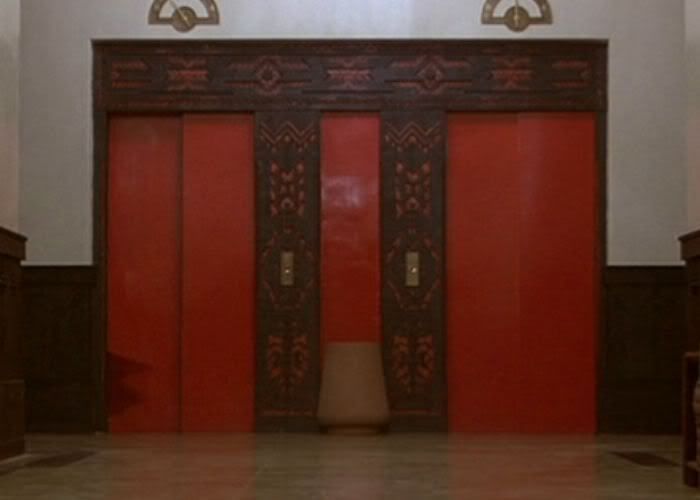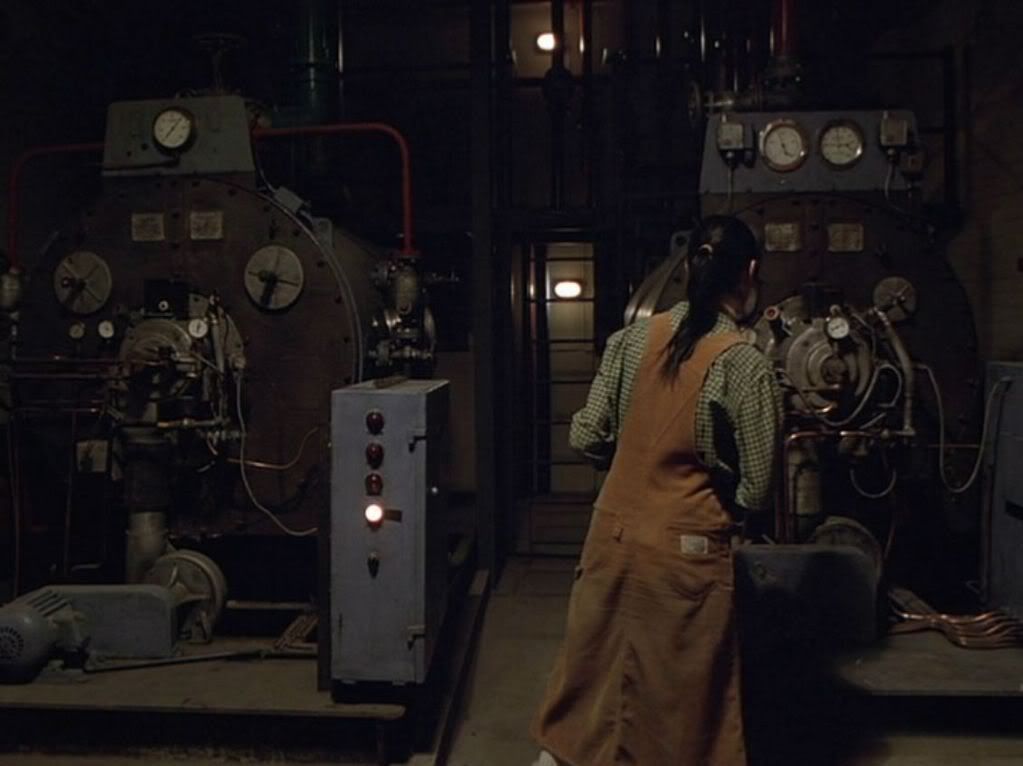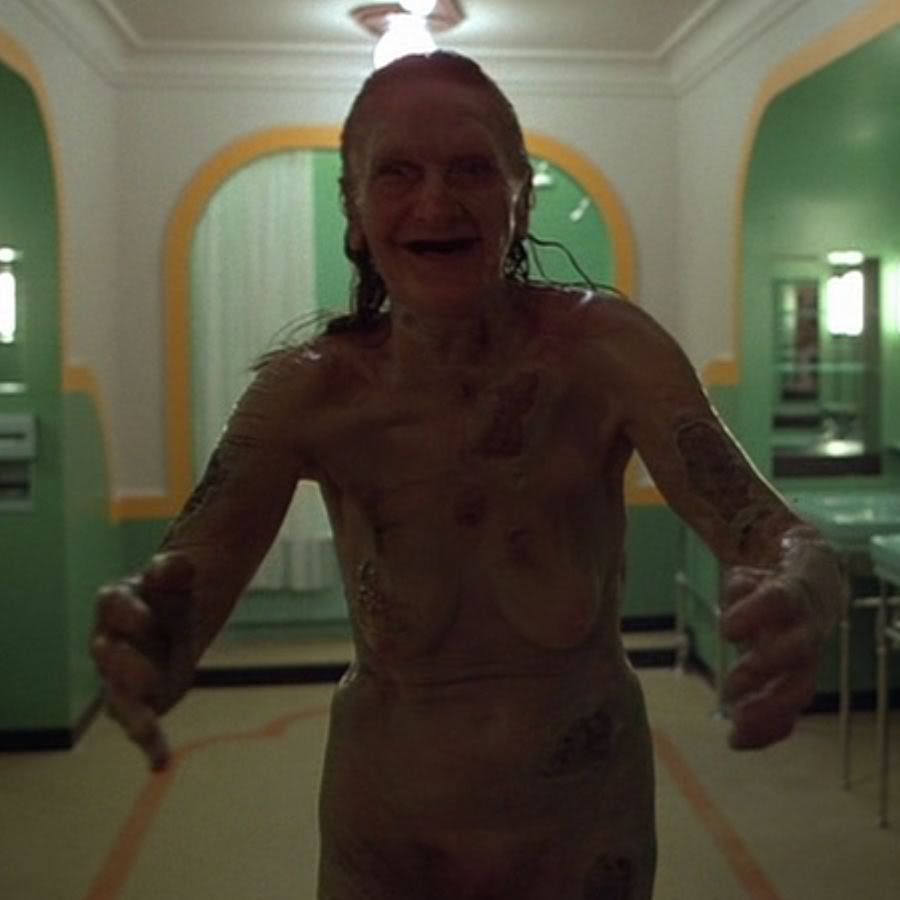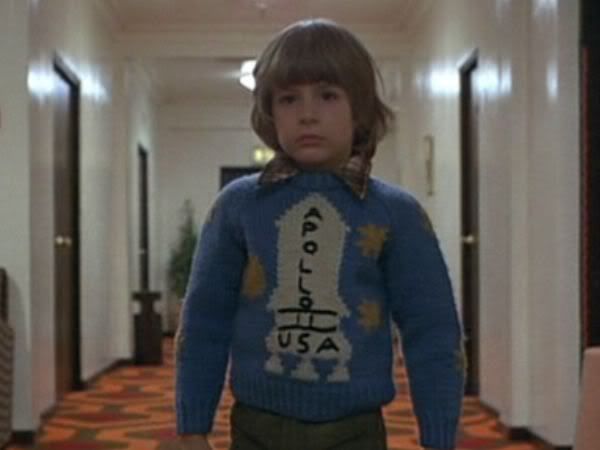..“The Shining” is one of the most enigmatic movies in history and the obvious visual images Stanley Kubrick placed in it can't be ignored. There are hundreds of continuity errors in this movie but some of them were placed there on purpose and need to be looked at closely.
There’s no question that Dick Hallorann has a special supernatural ability. He “Shines” and talks telepathically to Danny in the storeroom and as he does a red Calumet can appears out of nowhere right next to his head, only to disappear in the very next shot when he stops "Shining".


Unless you look closely you'll miss this. When Jack talks to Delbert Grady the exact same thing happens as, now, several red Calumet cans appear out of nowhere right next to his head. They also weren’t there when Wendy dragged him in. They just appear out of thin air the same way.


Think about the similarities in the two scenes;
They’re both in the same place.
They’re both talking to someone in a supernatural way.
And the same red Calumet cans appear out of nowhere on the shelves behind their heads.
The red Calumet cans that appear out of nowhere are not some common run of the mill movie mistake, they're important to the story. You can’t say Dick Hallorann is “Shining” and Jack is not when the exact same bizarre thing happens to both of them. Stanley Kubrick has hidden something in these movements.
They both have the same ability and it’s no stretch of the movie's reality to see that Jack also “Shines” in the storeroom. The increase in the number of cans indicates how much more of this ability Jack has over Dick Hallorann. This helps answer one of the most perplexing plot errors of this movie. How is it that Dick Hallorann, inexplicably, doesn’t know that Jack is hiding around the corner with an ax at the end of the movie? Jack can simply out ”Shine” Dick Hallorann who is unable to utilize his special ability to foresee the end his life.
Don’t forget the little hints that Stanley Kubrick sprinkles around the movie that point to Jack’s ability to “Shine” like Wendy bringing him breakfast in bed and we hear the obvious play on words,
“I made ‘em just the way you like ‘em, sunny side up.” and Stanly Kubrick placing a red box from the
"Golden Rey" company (pronounced ray), another play on words, that also appears out of nowhere between shots in the same scene next to his head.


There’s something else in this scene that lets us know that Jack has the ability to “Shine” as we look at Danny obviously posed next to a different red
“Golden Rey” box of sliced pineapples as he "Shines". Get out your copy of the movie and listen to the sound effect we here during this scene (:27 into the movie).


There’s no doubt that Danny is “Shining" as he talks telepathically with Dick Hallorann in the storeroom. The weird sound effect we hear, as well as the red box, alerts us to this and is also part of the scene like the moving Calumet cans I just showed you. How can you say that Jack is not doing the same thing when Stanley Kubrick lets us hear the exact same weird sound as he visions Wendy and Danny playing outside throwing snowballs at each other in the snow (:46 into the movie)? When Dick Hallorann sees the vision of room 237 again we hear a similar sound effect (1:11 into the movie).

When Danny sees his vision of the bloody elevators we know it’s a product of his ability to “Shine” (:11 min. into the film). This is never disputed, then how can it be any different when Wendy has frame for frame the exact same vision of the bloody elevators at the end of the movie (2:14 into the film).



This is so obvious. They're seeing exactly the same vision of the bloody elevators and you cannot say that Danny is “Shining” when he sees his vision and Wendy is not “Shining” when she sees her vision. It’s exactly the same. Danny doesn't "Shine" it into her head either. Stanley Kubrick goes way beyond meticulous here and you have to observe this scene very carefully. The scuff marks on the floor in front of the elevators show us something important. The point of view is different each time we see the bloody elevators so even though they're seeing the same thing frame for frame each vision is totally unique to that character; they are seeing twin visions. The scene was shot with two adjacent cameras (Wendy’s on the right and Danny’s on the left) giving each character their own unique point of view. Can you think of any other scene in the history of moviemaking that was shot like this?


Wendy's ability becomes more apparent in direct proportion to her state of mind, but they are still doing the exact same thing and the pictures Stanley Kubrick placed in his finished work don’t lie and can’t be changed just like the ones of Dick Hallorann and Jack in the storeroom. They both prove the same thing.
Mr. Ullman’s tie changes color right before our eyes in these two sections of the same scene.


In the novel Dick Hallorann says this to Danny, "If there is trouble ... you give a call.” and Danny calls him several times. In the movie Dick Hallorann never says this line and Danny never calls him. There’s another reason why Dick returns to The Overlook from sunny Florida. Stanley Kubrick gives this explanation in his dialogue in Dick Hallorann's phone call to Larry Durkin at the gas station,
“They've turned out to be completely unreliable assholes. Ullman phoned me last night, and I'm supposed to go up there and find out if they have to be replaced.” What he says is crystal clear and must have an explanation. Dick Hallorann never lies or exaggerates anything to anyone in the film (or the novel). How can this statement be true? It can't be debated, he says that Mr. Ullman ordered him to go back to The Overlook but how on earth does his boss know what’s happening at the hotel; the phones are out? Mr. Ullman knows because he has the same ability to see visions as the others. There’s absolutely no violation of the movies reality here. Stanley Kubrick simply makes an alteration from the novel and has another person viewing the same vision as Dick Hallorann, at the same time. It’s just been hidden from the audience. Like John Lennon sang in the song, "Instant Karma", that inspired Stephen King’s novel....
“We all ‘Shine’ on!” He’s taken those words from the song and turned them into the movie's reality. In Stanley Kubrick's Overlook that means Mr. Ullman too. He “Shines” and sees the exact same image of Jack in room 237 with the old woman that Dick Hallorann is seeing. In "The Shining's " reality there’s no other explanation as to how he would know something was wrong and order Dick Hallorann back to The Overlook. It’s now Stanley Kubrick’s "Overlook" and he can give that special supernatural ability to any character he wishes. Stanley Kubrick even puts this in the dialogue so there is no confusion of this fact,
“But, there are other folks though mostly they don’t know it, or believe it”.But what if you believe Dick Hallorann is lying to Larry Durkin about Mr. Ullman calling him, or lying or exaggerating about anything else in the movie (click here if you believe this could be true)?How much proof is needed? Wendy, Jack and Mr. Ullman can also "Shine".You might not feel it in your gut (yet) but can anyone prove that they don't have this ability? Give it some time. At first this seems shocking as it's so cleverly hidden from the audience but you must remember it's Stanley Kubrick’s "Overlook" and he can do anything he wishes to alter the story; no matter what opinion viewers may have. He can hide anything he wishes but the pictures don’t lie. Again, he even tells us in the dialogue what he’s doing as Dick Hallorann says this to Danny about other people with their special gift,
“But, there are other folks though mostly they don’t know it,............................ or believe it”.There are only a few characters in this movie, who do you think Stanley Kubrick was talking about when he wrote this? In the novel The Overlook covets Danny for his power and uses Jack to get it. What does it covet in the movie? Think about it for a second The Overlook is trying to kill Danny and ends up with Jack on the wall. It’s obvious that in the movie this time, if it wants anything at all, it wants Jack. Why would The Overlook want him if he didn’t have the most power to covet?
At this point you may be wondering why Dick Hallorann only seems to pick up on Danny’s special ability if these other people also have the “Shine”?Stanley Kubrick lets us know,
“there are other folks” but why does Dick Hallorann only seem to pick up on Danny’s special ability if these other people also have the “Shine”? In the novel Dick Hallorann meets several people that have the “Shine”. He knows it right away and so do they
(“A Shine knows a Shine”, page 217 Chapter 38). Stanley Kubrick reverses the novel again. In the movie ‘a Shine doesn’t know a Shine’. The others don’t know that they have this ability and he plainly tells us this in the dialogue,
“Though mostly they don’t know it”. Dick Hallorann is obviously not able to perceive it in them, and in the film he’s the only one we know of who knows he has the “Shine”. Then I realized that I had a huge problem to solve because it appears that he knows right away that Danny possesses the “Shine”. How could he not know about the others the same way? At first I thought that Danny’s age has something to do with him picking up on it. But that’s not it. Then I thought when Danny “Shines” in the game room seeing the twins, maybe that’s when Dick picks up on his ability. But that’s not right either. I went back to look at the scene again because I knew Stanley Kubrick wouldn’t leave out the answer. I couldn’t believe what I found; Dick Hallorann doesn’t know that Danny “Shines” at all. This seems crazy because it’s so incredibly well hidden by Stanley Kubrick in the dialogue. Look again at the question Dick Hallorann asks Danny in the kitchen,
“Do you know how I knew your name was Doc?” The obvious question should have been, do you know how I spoke to you in your thoughts and said,
“How'd you like some ice cream, Doc?” But he doesn’t mention the obvious elephant in the room. Because of the director’s brilliant manipulation we all just assume that Dick Hallorann starts the thought transfer between himself and Danny. This isn’t the case at all, if you look at the film it’s Danny that “Shines” first and Dick Hallorann is then able to pick up on the boy’s ability. That’s when he knows for sure and transfers the thought into Danny’s mind for the first time. In the film this is so important; Dick Hallorann only knows someone possesses “The Shine” if it’s directed at him. Again we know from Stanley Kubrick’s dialogue that there are others. And in a story with only five main characters it doesn't leave many for you to choose from.
How do you think those red Calumet cans behind Jack and Dick Hallorann’s heads appear right out of nowhere? And how about Mr. Ullman's tie?The assumption that what I just showed you are accidental continuity errors is nonsense. There are many explanations that could explain individual shots but taken as a whole it’s pretty obvious with going on here - it's intentional. Stanley Kubrick places them up front to be noticed. They're part of the movie and within the framework of "The Shining's" reality they must have an explanation. Either The Overlook does it or they did it themselves but whatever the answer; a supernatural power is involved. There's no other answer yet many viewers form their own rock solid opinion's choosing to ignore the pictures that Stanley Kubrick placed within the movie, or choosing to ignore the dialogue he put into the movie, or not reading Stephen King’s novel and understanding the alterations that were made to it. Like the magically appearing Calumet cans and Mr. Ullman’s tie changing color before our eyes, a supernatural power is involved.
How can I proove that there are supernatural movements in Stanley Kubrick's Overlook?There were supernatural movements in Stephen King's Overlook also. After all this is where Stanley Kubrick got the idea for the movie from and we must look there for some answers - and not ignore what we find.
For me the best and creepiest part of the novel was when The Overlook animates certain objects for its guests. It’s classic horror and Stanley Kubrick wouldn’t leave out such a great plot point from the novel. You just have to look very very closely if you want to see what actually moves.
Three items move through supernatural power in the novel. The Overlook animates The Hedge Animals, the fire hose, and the elevators. They’re all possessed by the hotel and scare the crap out of the Torrance’s because they obviously can move on their own. But what Stanley Kubrick did to these three items in the movie just cannot be denied or ignored.
He’s totally inverted Stephen King’s novel and no one can dispute that these three items, glaringly if not hauntingly, remain totally motionless throughout the entire movie instead of moving by themselves (click here). Stanley Kubrick is “Shining” a vision right into our heads. Look at them all you like, because, in the movie, they will not move an inch (the elevator doors only move in the visions - not in the hotel). This is telling us something important.



Stanley Kubrick reversed what moves by supernatural powers in the novel and this leaves it open for anything other than these three items to move under mysterious supernatural circumstances; and in Stanley Kubrick's Overlook that's exactly what happens.
While he's scolding Wendy Jack pulls the sheet of paper out of the typewriter. After he's finished he makes another sheet appear back in the carriage again right out of thin air without touching it and without the audience hearing a thing.

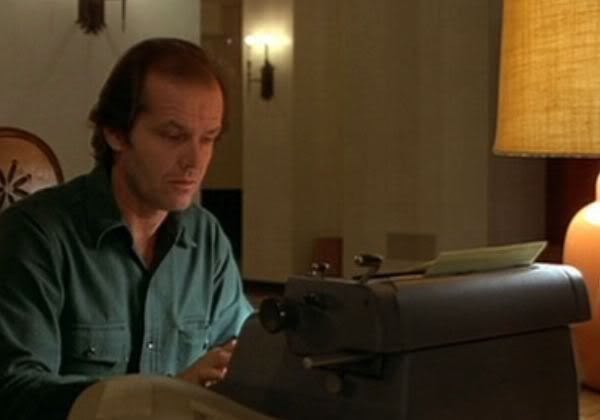 So many items move when they shouldn't how do I know that it's not spooks inside The Overlook that are doing this?
So many items move when they shouldn't how do I know that it's not spooks inside The Overlook that are doing this?Over ninety five percent of the movie is shot inside the hotel but there are scenes that take place outside of the hotel and these supernatural movements also happen in them. After Danny "Shines" and sees the vision of the bloody elevators watch the yellow and red dwarf Dopey as he makes it disappear from his bedroom door long before he enters the hotel.



In sunny Florida, Dick Hallorann "Shines" when he sees room 237 and makes the red painting above his headboard dissappear.


There's no other explination as the exact same thing happens outside of the hotel and well before Danny ever gets there. The characters posses a supernatural ability that also enables them to alter their surrondings. This is what the movie is about a supernatural ability; "The Shining". What a brilliant way Stanley Kubrick chose to alter their special ability from the novel. He works in the visual realm and made these character’s supernatural ability look like a common movie mistake. Again, Stanley Kubrick tells us others have the ability to “Shine” in the dialogue.
“But, there are other folks though mostly they don’t know it,............................ or believe it”......................And one of them is insane.
What's happening couldn't be more obvious. In the reality of the movie this must have an explination. The definition of psychokinesis (aka. telekinesis) is: the power to move a physical object by thinking about it without the application of physical force. Stanley Kubrick has made it quite obvious that when they "Shine" cast members in his movie also possess the ability to supernaturally move or change the color of items.
There's so much to show. As he tries to save himself from his father, Jack "Shines" and moves the entrance of the hedge maze closer to Danny in order to entice and trap his son in the maze. (Early on when we see this area several times, and in the hedge maze maps, there’s only one entrance to the maze and it’s not on the wall facing the hotel. Later the entrance moves from its original position to the wall 90 degrees to the left, and we now see it facing The Overlook. This can be seen best just before they escape the hotel as Danny walks straight into Wendy’s arms at the end of the movie. She’s standing right in front of the rear entrance of The Overlook where Dick Hallorann parked the Sno-cat. Earlier we see this same spot and there’s no entrance there.)



Skeptics say Stanley Kubrick didn’t alter the novel and give these characters the additional ability to psychokinetically move things but they'll have to have a good explanation for what happens in this picture. It's so obviously playful and also very well hidden - right in plain sight.


We see their trip up the mountain and they're the only ones on the road heading toward The Overlook. Just like when he moves the Calumet can, the Golden Rey box and opens the latch of the storeroom, Jack "Shines" and uses psychokinesis to move the unnaturally large pile of luggage on the right that couldn't fit in a VW if the engine and passengers were removed. It just appears at the end of their journey (without any indication of any outside help or a shred of luggage on or in the car). A supernatural power is involved, there's no other explanation of how the luggage got there. They had no other help.
People who “Shine” emit psychic energy and are able to power the TVs in The Overlook and again outside of The Overlook, at Dick Hallorann’s house, with no visible wires coming out of them.


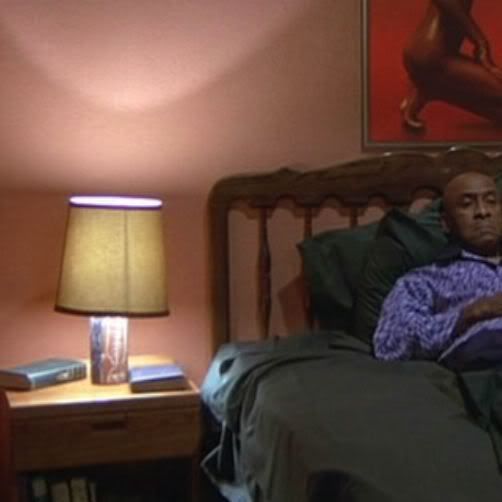
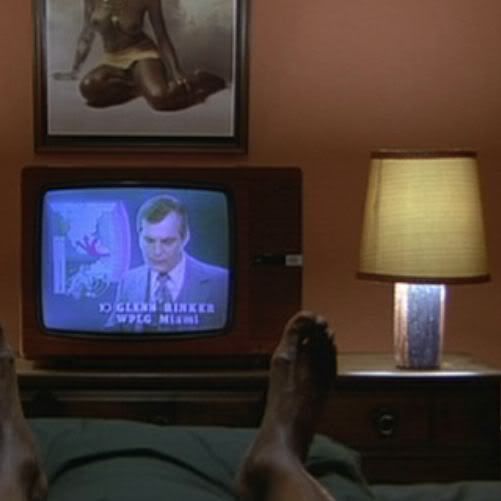
You may have noticed as Jack gets crazier and crazier, whenever we see the outside of The Overlook different sets of lights are on each time. Especially in the end where no one ever flicks a light switch. Throughout the chase scene different lights go on and off by themselves even though no one is inside the hotel. It’s a no-brainer to say that the hotel is haunted and the spooks are causing this to happen but if you look deeper it’s not the case at all. It's like I showed in a previous section, the TV sets, Jack’s lamp on his desk, the clocks on the walls all have no wires coming out of them, these people have a special energy around them. Jack's descent into madness combined with his power to “Shine” can also cause odd things to happen like lights turning on and off by themselves.
Many items change color when they shouldn't. Danny didn't bring 2 trikes with him yet the wheels change color from white to red.


Jack didn't bring 2 typewriters either yet it also changes color.


Their room, same thing. They didn't repaint it durring their stay.


It's been painted a different color (by Stanley Kubrick's crew) as the back wall is also the same color.

The hallway in the final chase.
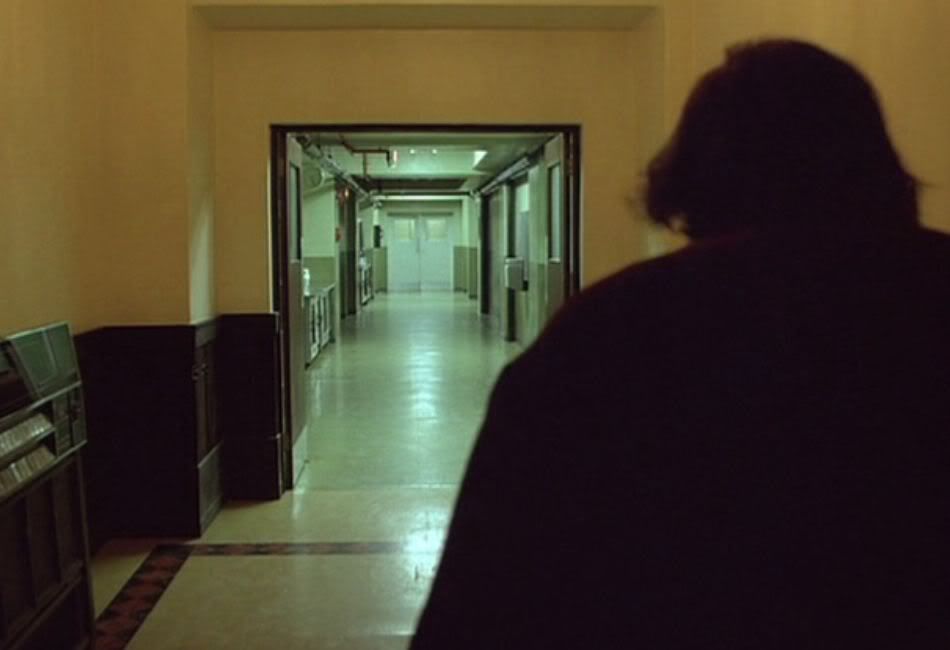

It's all a result of "Shining". That's what this movie is about.
Her state of mind is desperate and after Wendy drags Jack into the storeroom she changes the direction that the knives are facing. How many times does Stanley Kubrick have to make the knife reverse position or dissapear?


Later in the bathroom, she moves the same knife again. She throws it in the sink with the handle to the right, yet later when picking it back up she reverses the handle’s position to the left without ever touching it.


In the end when she doesn't need it anymore Wendy throws the knife down into the packed snow and now it disappears.
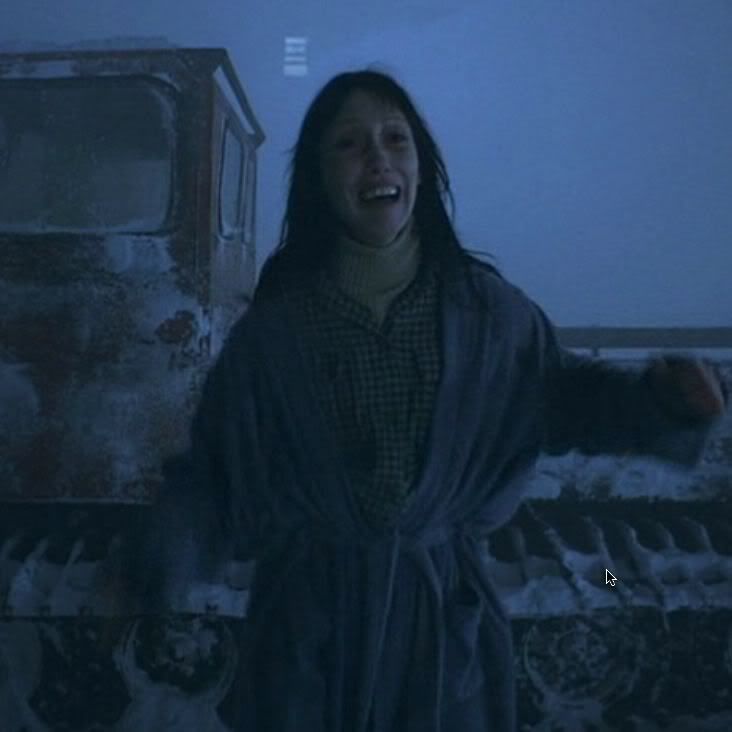

The knife also reverses position between shots when Danny "Shines" and Tony writes "Redrum" on the bathroom door.
 You might be wondering about this; how could the characters not know that something moves around them?
You might be wondering about this; how could the characters not know that something moves around them?The answer is found in Stephen King's novel when Danny talks about the Moving Hedge Animals and says,
"It only happens when you're not looking.” Stanley Kubrick makes this sentence come alive in the movie. If you observe the characters closely they're never looking directly at the object that moves. Most are directly behind their heads and you must also remember it's a movie about a supernatural power, stuff happens. The movements are for the audience not the characters in the movie. Stanley Kubrick works in a visual realm, he reverses the sentence from the novel and now in the movie,
"It only happens when [the audience is] looking.” But you do have to know where to look.
But Dick Hallorann doesn’t say anything to Danny about telekinesis as they speak about the "Shine" in the hotel's kitchen.Hiding things must be something Stanley Kubrick enjoyed and making it overly obvious would have spoiled his fun. It's been hidden. Dick Hallorann simply doesn’t know about it, again, "It only happens when you're not looking.” If he knew everything there would be no movie and the fact that he doesn't means nothing. This is discussed by Stanley Kubrick in his interview with
Michel Ciment . "If Danny had perfect ESP, there could be no story. He would anticipate everything, warn everybody and solve every problem. So his perception of the paranormal must be imperfect and fragmentary. This also happens to be consistent with most of the reports of telepathic experiences."
The same applies to Dick Hallorann. There's something else Dick Hallorann doesn't know about; he also has an invisable friend (click here) that Stanley Kubrick didn't tell Michel Ciment about.







